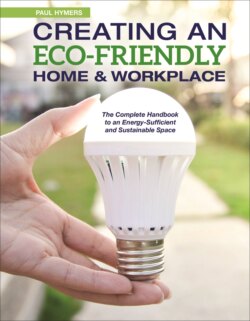Читать книгу Creating an Eco-Friendly Home & Workplace - Paul Hymers - Страница 34
На сайте Литреса книга снята с продажи.
The amount of light
ОглавлениеBecause most of us have not given much, if any, thought to how much light we need and its cost to the world, we have been over-lighting our homes. It isn’t easy to estimate how much light you need until you’ve spent some time turning down lights or switching them off because they annoy you. You might want to experiment with an extension cable and various lamps to see just how much light each can generate. Not only will this give you ideas of the type of lamp you’ll need, but also its wattage, or power. The only problem is that it will be difficult to visualize the final effect until the decorating is complete.
White walls reflect about 70 per cent of the light falling on them; dark ones may return only 30 per cent; grey slate floors will absorb all but ten per cent of the light shining on them. As a rough guide, dining-rooms need about 50 lux (soft enough to produce a relaxed atmosphere, but sufficient to be able to see what you’re eating), kitchens should have about 300 lux, as should stairways for safety. The spread of light is also an issue, and for this you need to be aware of the angle of the beam generated by a particular lamp. The packaging should reveal this. Those halogen spots we peppered our ceilings with in the late 1990s burned 35 or 50 watts of power each, but they only shed about 500 lux to the floor directly beneath them. With a low-angle beam, they didn’t spread light very far.
